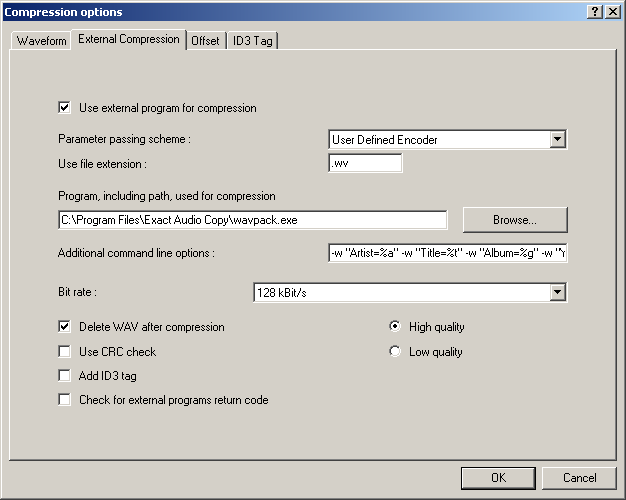EAC and WavPack
Important note
This guide is in need of an update, because in EAC 1.0 beta 2, the replacement strings changed. For example:
- "%s" is now "%source%"
- "%d" is now "%dest%"
- "%a" is now "%artist%"
A page has been created to describe the change and convert between the two sets of command-line placeholders at EAC placeholders. See also the original list in the EAC FAQ or in the EAC Compression Options guide.
Software needed
Installation
Note: This guide assumes that EAC is has been configured for secure ripping, if not please follow this guide.
- Unzip Wavpack into the same directory that EAC is in.
Configuration
- Open EAC and insert a CD into the drive.
- Click the EAC menu and select Compression Options.
- Click the External Compression Tab, and put a check box in use external program for compression.
- Change Parameter Passing Scheme to User Defined Encoder.
- Change user file extension to .wv if not already that.
- Click the Browse button and locate the WAVPACK.EXE that you unzipped earlier.
- Remove the ticks from Use CRC check, Add ID3 tag and check for external programs return code.
- In the Addtional command line options box, copy and paste the string below.
- If you are using EAC 1.0 beta 2 or newer, then in the Additional command line options box, copy and paste the following string:
-h -w "Artist=%artist%" -w "Title=%title%" -w "Album=%albumtitle%" -w "Year=%year%" -w "Track=%tracknr%" -w "Genre=%genre%" %source% %dest%
- If you are using EAC 1.0 beta 1 or earlier, then in the Additional command line options box, copy and paste the following string:
No Tags:
-h %s %d
APEv2:
-w "Artist=%a" -w "Title=%t" -w "Album=%g" -w "Year=%y" -w "Track=%n" -w "Genre=%m" -h %s %d
Note: If a user wanted to change compression settings on Wavpack the green portion what you would substitute with the new preset.
- Do not worry what bit rate is shown in the bit rate drop down box, this will be ignored.

Hybrid mode
If you want to create a correction file while encoding from EAC you will need to adapt your normal command line slightly, to ensure that the correction file ("<name>.wvc") is named the same as the primary file ("<name>.wv"). If you do not follow these guidelines your correction file will be named incorrectly, using the temporary filename that EAC uses while processing.
Since Wavpack 4.1 beta you can specify an additional file path when using the -c switch to request a correction file. This filepath will be used to name the correction file.
The suggested method to implement this feature is to utilise the Use CRC check checkbox on the External Compression dialogue, to specify whether a correction file is required or not. In conjunction, you must also add the following to the end of your command line:
%c-c %o%c
For example:
-w "Artist=%a" -w "Title=%t" -w "Album=%g" -w "Track=%n" -hb320 %s %d %c-c %o%c
When you check Use CRC check the -c switch, and the file path specified by the EAC placeholder %o, will be included in your command line, creating a correction file with the correct file name. With Use CRC check unchecked no correction file will be created.
If you do not want this configurability, simply add:
-c %o
All encodes will then include a correction file, which is named correctly.
Embedding the cue-sheet in an audio image file
If you prefer to rip to an image file, and want to embed the cuesheet in the image, you can add the following tagging switch to your command line:
-w "Cuesheet=@*.cue"
This uses two of WavPack's features. Firstly, the '@' tells WavPack to set the 'Cuesheet' tag from the contents of a file. Secondly, the wildcard '*' tells WavPack to find the file itself, given the '.cue' restriction (i.e. "find the first '.cue' file you come across").
PLEASE NOTE: This will only work if there is one CUE file in the folder. WavPack will exit because of this command, if you have an existing cuesheet in the folder before starting. The easiest way is simply to ensure that you either move your previous rips beforehand, or rip to a new directory each time.
Example command-line:
-hm -w "Cuesheet=@*.cue" -w "Artist=%a" -w "Album=%g" -w "Year=%y" -w "Genre=%m" %s %d
